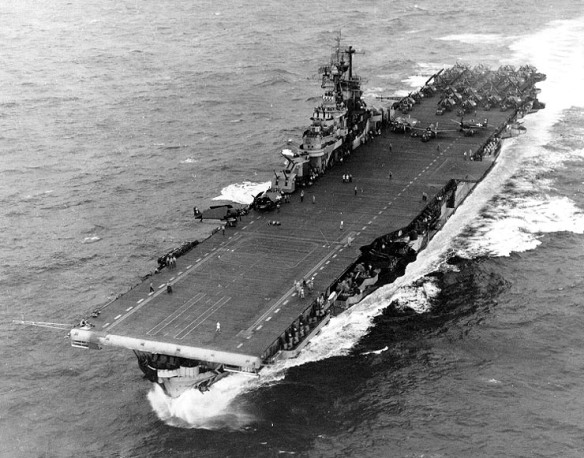USS Intrepid (CV-11) in the Philippine Sea, November 1944.
As 1943 drew to a close, deployment of Essex-class aircraft carriers irreversibly tipped the scales of air power in favor of the United States and enabled Admiral Nimitz’s central Pacific offensive, code-named Granite, to progress in earnest. Carrier-based air superiority conveyed two fringe benefits: strategic mobility and relative naval supremacy. With carrier-based aircraft, Nimitz therefore had much greater strategic mobility. Conversely, without adequate air cover, the Imperial Japanese Navy’s effectiveness was greatly decreased because its transportation and communications were severely limited.
The end of treaty restrictions on the individual size and overall numbers of carriers presented the United States Navy with the opportunity to construct a carrier force incorporating all the lessons and experience from the fleet’s experiments and operations since the 1920s. The new Essex class design, derived from the earlier successful Yorktown class, featured a 25 percent larger air group, a 50 percent increase in defensive armament, machinery rearranged for better survivability, and substantially improved armor protection, most notably the addition of a 3-inch armored hangar deck. All these improvements came at a price. Overall dimensions increased by some 10 percent to meet requirements for more accommodation space, stowage for bunker and aviation fuel and munitions, and 25 percent more powerful machinery to maintain speed, while displacement rose by 37 percent.
The Essex class was a highly successful design. Improved passive protection demonstrated its value, especially in the face of kamikaze strikes that caused very serious damage to four of the class, all of which survived. The larger flight deck and deck-edge elevator greatly facilitated large-scale rapid aircraft operations. The design was large enough to accommodate bigger air groups of larger machines than envisaged originally (late war examples operated as many as 103 aircraft rather than the 91 as designed). As the war progressed, the light antiaircraft battery of Essex class carriers more than doubled in size and there was a major expansion of the radar suite. Nevertheless, by war’s end the class was very crowded, since complements had grown by 50 percent to serve the larger air groups and enhanced batteries and equipment suites.
Design: The design for this class, the largest single group of fleet carriers ever constructed, was envisaged as an improved Yorktown, incorporating a 10 percent enlargement of the air group, improved protection, subdivision, and machinery arrangements, better flight deck layout, and an increase in the antiaircraft battery. All this was achieved, but the final design was almost 30 percent larger. The midship elevator was located at the port deck edge, while installing the starboard 5-inch guns in twin mounts fore and aft of the island not only enlarged the flight deck but also increased the heavy antiaircraft battery by 50 percent. The design called for three catapults: two on the flight deck forward and the third (a transverse unit) on the hangar deck. Production shortages meant most early units of the class completed with only one catapult, either on the flight deck or in the hangar, but eventually all carried the two flight deck catapults alone. Protection was enhanced by better subdivision, arranging the machinery on the unit system, and adding armor, principally in the form of 3-inch protection on the hangar deck. Two units, the Reprisal and the Iwo Jima, were laid down but never completed, while an additional six units were authorized but never commenced construction.
Modifications: All ships received greatly enhanced light antiaircraft batteries as World War II progressed. The final arrangement included seventeen or eighteen quadruple 40mm mounts (the longer bow of the Group II vessels was a design change to allow fitting two mounts with enhanced sky arcs beneath the forward end on the flight deck instead of the single mount on the earlier vessels), and up to sixty 20mm weapons in single or twin mounts. These carriers also received updated and expanded radar suites and replaced some or all of their rigid antenna masts with whip antennae. The stowage for aviation gasoline was revised for greater protection and internal subdivision improved by extending unpierced bulkheads one deck higher. Air groups expanded to as many as 103 heavier aircraft by the end of World War II, requiring additional fuel, munitions, and crew accommodations, plus stronger arresting gear. By the end of World War II the complements of the class reached 3,385 officers and men.
Most of the class received major reconstructions, described separately. Those not reconstructed were stripped of most of their light antiaircraft battery to reduce weight and crew size. The Boxer, the Leyte, the Princeton, the Tarawa, the Valley Forge, and the Philippine Sea were converted to antisubmarine carriers between 1953 and 1956. The Boxer, the Princeton, and the Valley Forge converted to amphibious assault ships between 1959 and 1961.
Displacement: 27,200 tons (standard), 34,880 tons (full load) Dimensions: Group I 872’0” (oa), Group II 888’0” (oa) x 93’0” x 23’0” (mean), 27’6” (full load) Flight deck: 860’0” x 96’0” Machinery: Westinghouse geared turbines, 8 Babcock & Wilcox boilers, 4 shafts, 150,000 shp = 32.7 knots Bunkerage & range: 6,330 tons = 15,000 nm @ 15 knots. Aircraft: 91 Armament: 4 x twin 5” DP, 4 x single 5” DP, 8 x quadruple 40mm AA, 46 x 20mm AA Complement: 2,682
